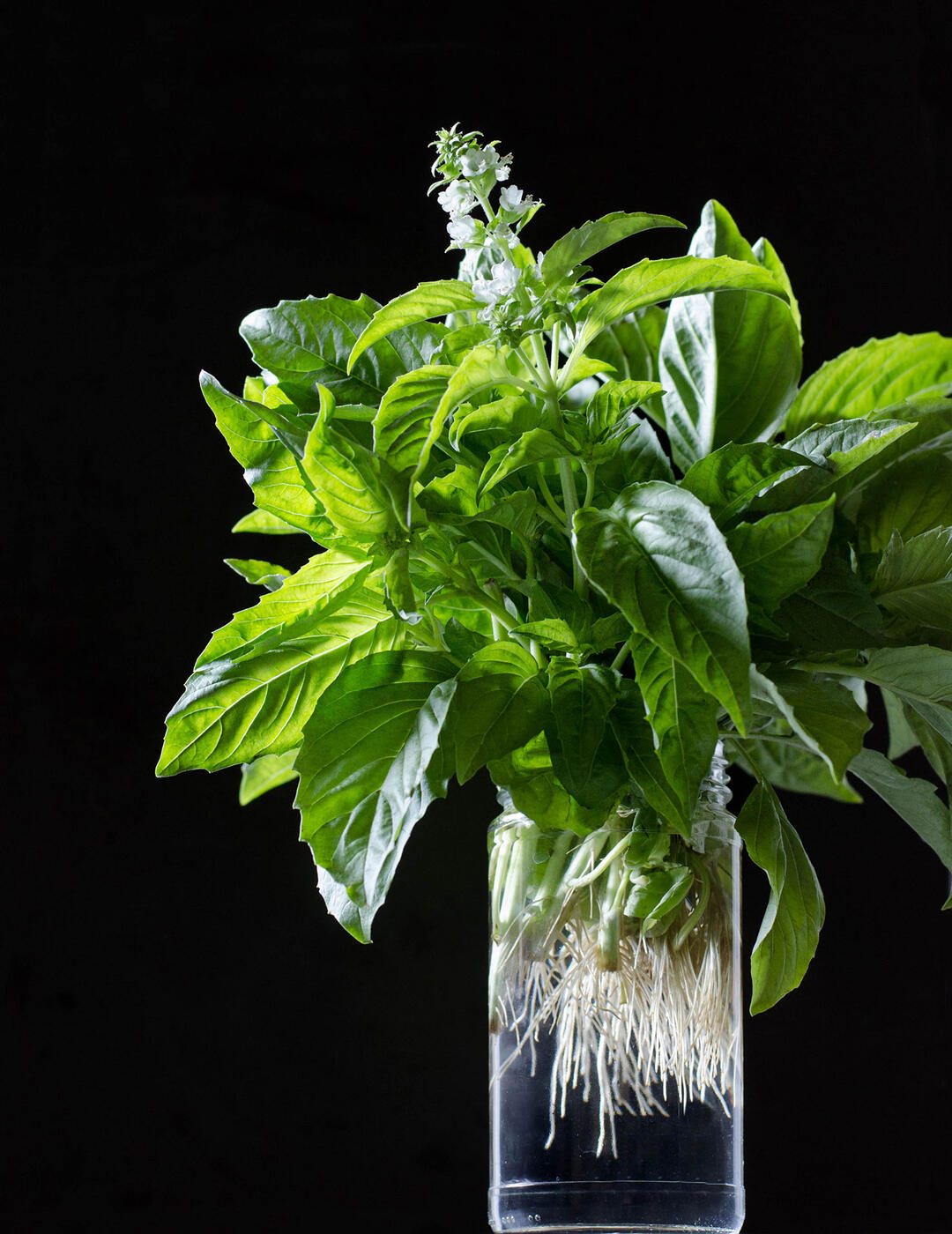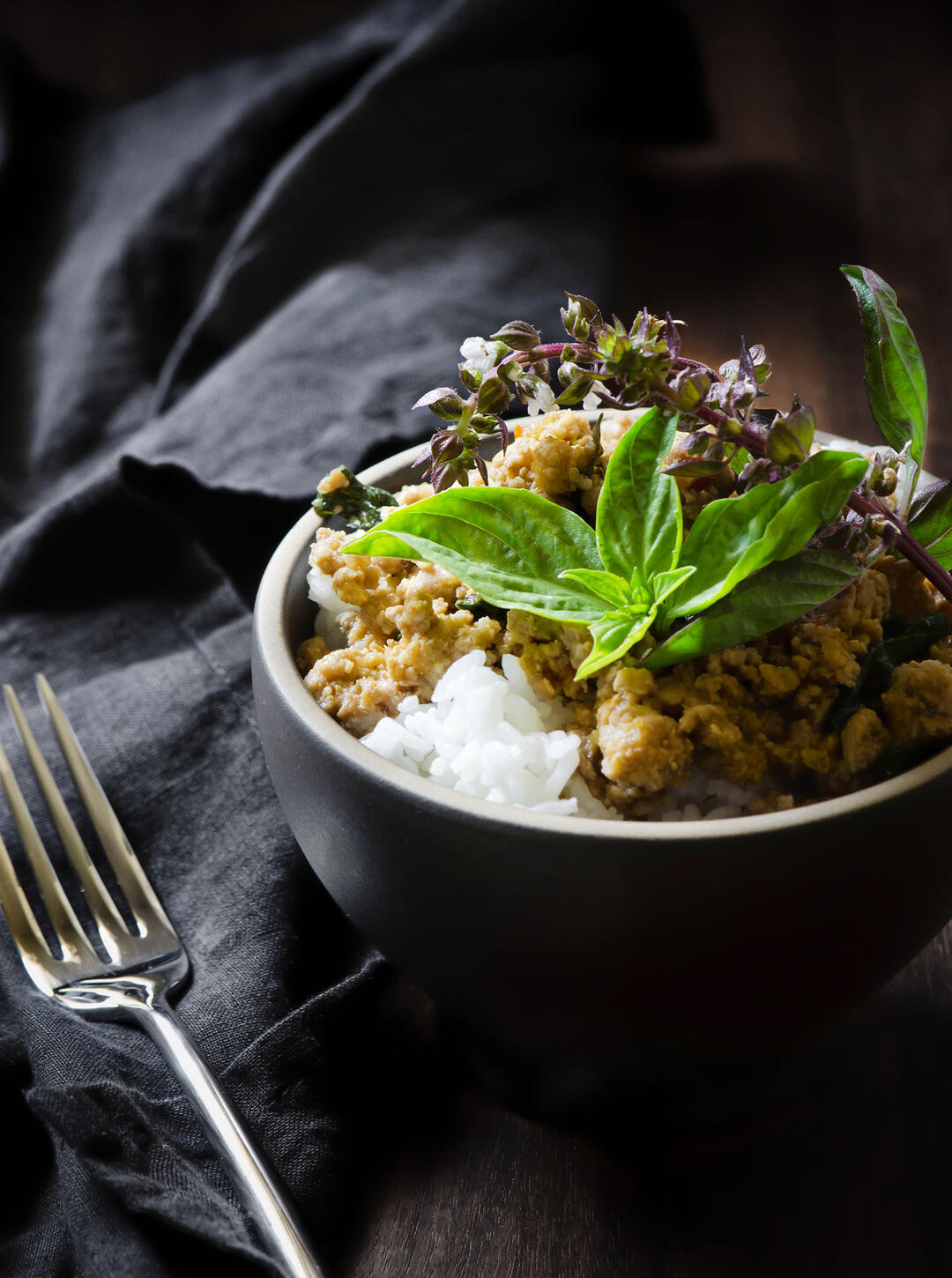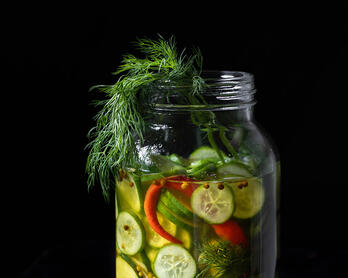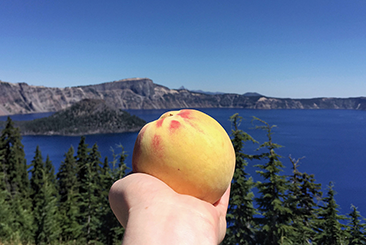Thai Spicy Pork & Basil

I make Thai Spicy Pork & Basil a couple of times a year, roughly between May and September when the smell of basil permeates the farmers market. I whipped up the first spicy pork of 2019 last week and realized the recipe wasn't on the blog which felt like an oversight. So here we are.
Thai Spicy Pork & Basil is adapted from Cook's Illustrated's The Best International Recipe. The original is made with ground chicken but at some point along the way I switched to pork as the protein. The flavor of this dish is an ideal balance of umami, fresh herbs, and heat, and the leftovers are excellent. In addition to being delicious, the cooking process is neat and tidy. You can prep the ingredients while the rice is cooking and then bring things together in short order while the rice is still hot in the pot.
Italian vs. Thai vs. Holy Basil
The Cook's Illustrated recipe calls for Thai basil and suggests Italian as a substitute. My version uses Italian since that's usually what I have on hand.
When researching the different varieties for this post, I noticed that holy basil is often mentioned as traditional for Thai dishes but is apparently hard to find in the States. Also noteworthy is that holy basil seems to be the herb of choice for a number of recipes that were very similar to the one included below.
Here's a brief overview.
Italian Basil
- Delicate leaves
- Sweet peppery flavor
Thai Basil
- Sturdier leaves
- Sweet and savory flavor with notes of anise or licorice
Holy Basil
- More delicate than Thai basil
- Distinctly spicy with notes of clove and black pepper
Italian basil can be substituted for Thai in a 1:1 ratio, but holy basil seems to be in a category of its own given the "intense spiciness" and savory notes. I'm hoping to use each variety this season for a side-by-side comparison but will probably reduce the quantity of holy basil (if I can find it).
Recipe Tips
Heat
Thai chiles pack a punch. I enjoy spicy food and use 4 of them in the recipe. If you're sensitive to heat, back the chiles down to 3. Also, use gloves when removing the seeds.
Basil
As mentioned above, the recipe suggests using Thai basil if you can find it but Italian will work fine. I have used the latter in most instances.
Oil
The recipe calls for vegetable oil but I use olive oil. There's not very much so I don't think it imparts any flavor.
How to Store Basil
I wrote a brief post about that here.

Farmers | Artisans
I make an effort to source my food from California artisans with a special focus on the Santa Monica Farmers Market. Below is a list of the folks who contributed to this dish.
- Peads & Barnetts // Pork
- A Cut Above Butcher Shop // Pork
- Koda Farms // Heirloom Kokuho Rose Rice
- Coleman Family Farms // Basil
- Kong Thao // Basil, Garlic
- Milliken Family Farms // Garlic
- Finley Farms // Shallots
- Trattore Farms // Olive Oil
Tools
- Gloves (to remove Thai chile seeds)
- Cuisinart 3-cup Mini Food Processor // I use this little processor a surprising amount and ended up buying the 4-cup version for the Airstream.
- OXO Mini Angled Measuring Cup // I started with one and now own three. Great little tool for under $5.
- Scale // Measure all the things.
My Favorite Cooking Tools spotlights the kitchen equipment I have owned and used for years.
Ingredients (Adapted from The Best International Recipe - Serves 3 to 4)
- 1 pound ground pork Note: Ground chicken can be swapped in for the pork without any additional changes.
- 3 1/2 ounces (105 grams) shallots, roughly chopped
- 4 Thai chiles, most seeds removed Note: Gloves are recommended.
- 5-6 (1/4 ounce or 20 grams) garlic cloves, peeled and roughly chopped
- 2 tablespoons olive oil
- 1 1/2 cups (3/4 ounce/25 grams) Italian basil leaves, cut into a rough chiffonade Note: The ribbons are about 1/2-inch wide. As mentioned above, the original recipe calls for Thai basil. Feel free to use that if you prefer but try to find leaves that aren't too tough.
- 1 1/2 tablespoons fresh lime juice
- 1/4 cup soy sauce Note: I started swapping in Fishy Sauce from Korean Vegan for half of the soy sauce.
- 1 tablespoon fish sauce
- 1/3 cup Homemade Roasted Chicken Stock Update: I recently used ham stock (can be made using a modified version of my homemade chicken stock recipe) and it was delicious. Either stocks are recommended.
- 1 1/2 tablespoons granulated sugar
- 1 teaspoon cornstarch
Instructions
Rice
- Cook rice per the instructions.
Mise en Place
- Puree the chiles, garlic, and shallots, then set aside.
- Combine 2-3 tablespoons of stock with the cornstarch then stir to dissolve. To the same bowl, add the remaining chicken stock, soy sauce, and sugar. Do not add the lime juice. Set aside.
When the Rice is Finished
- In a large non-stick pan, heat 1 tablespoon of olive oil over medium-high until shimmering. Add the pork, breaking it up as it cooks. When the pork is no longer pink, add a few cranks of freshly ground pepper and a pinch of flake-style salt. This takes about 5-7 minutes. Transfer the pork to a plate lined with paper towels and set aside.
- In the same large pan, add 1 tablespoon of olive oil and the onion mixture, then cook over medium to medium-high heat until it starts to look like a cohesive mash and the pan looks a bit sticky. Stir frequently and lower the heat if needed to ensure the mixture does not brown at all. This takes about 5 to 8 minutes.
- Add the pork back to the pan with the onion mixture and cook until heated through, then add the basil and cook until wilted. Stir frequently.
- Stir the sauce to recombine then add it to the pan. Cook for 2 to 3 minutes until thickened.
- Remove the pot from the heat and add the lime juice and a few cranks of pepper (or more to taste). Stir and taste. If you think the dish needs a little more acid, add more lime juice in small increments.
Serve
Serve immediately over hot rice.
Storage
The pork can be refrigerated in an airtight container. The leftovers never last beyond day 2 in our house so I don't know how long they keep.







